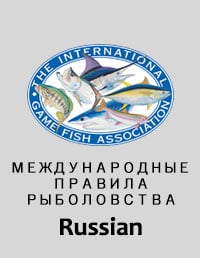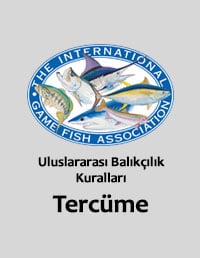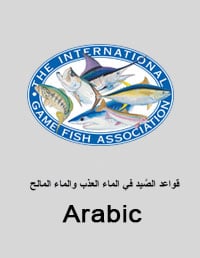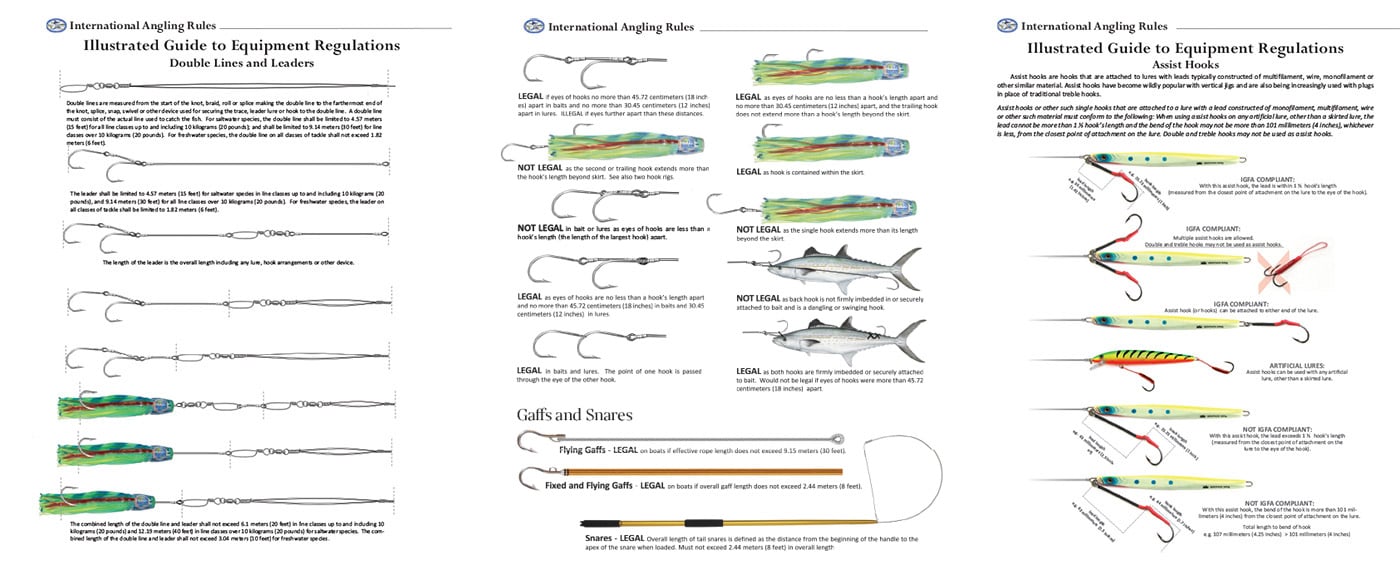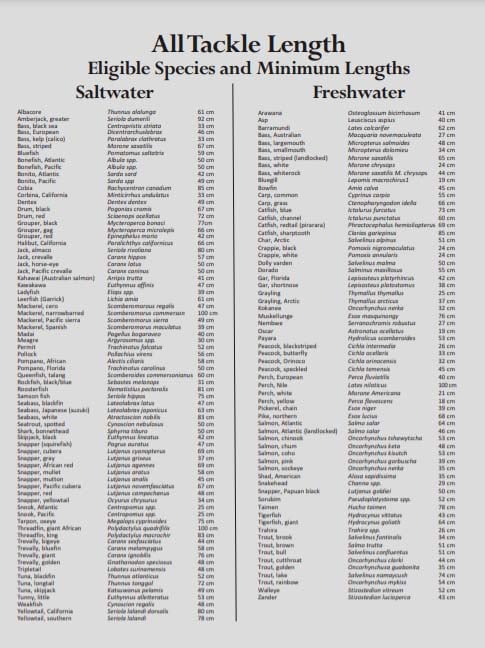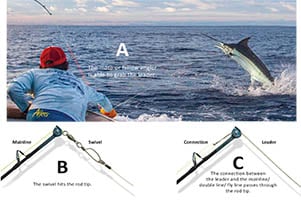IGFA International Angling Rules
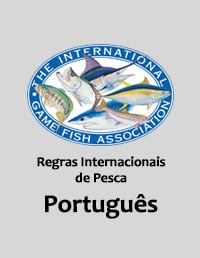
Portuguese Rules PDF
Coming Soon
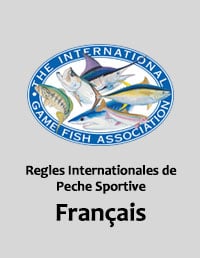
French Rules PDF
Coming Soon
The following angling rules have been formulated by The International Game Fish Association to promote ethical and sporting angling practices, to establish uniform regulations for the compilation of world game fish records, and to provide basic angling guidelines for use in fishing tournaments and any other group angling activities.
The word "angling" is defined as catching or attempting to catch fish with a rod, reel, line, and hook as outlined in the IGFA International Angling Rules. There are some aspects of angling that cannot be controlled through rule making, however. Angling regulations cannot insure an outstanding performance from each fish, and world records cannot indicate the amount of difficulty in catching the fish. Captures in which the fish has not fought or has not had a chance to fight do not reflect credit on the fisherman, and only the angler can properly evaluate the degree of achievement in establishing the record.
Only fish caught in accordance with IGFA International Angling Rules, and within the intent of these rules, will be considered for world records. Following are the rules for freshwater and saltwater fishing and a separate set of rules for All-Tackle Length and fly fishing. Fish caught in violation of laws or regulations governing the recreational catch or harvest of species or waters are not eligible for an IGFA World Record.
Rules for Fishing in Freshwater and Saltwater
(Also see Rules for All-Tackle Length and Rules for Flyfishing)
Equipment Regulations
A. Line and Backing
1. Monofilament, multifilament, and lead core multifilament lines may be used. For line classes, see World Record Requirements.
2. Wire lines are prohibited.
3. Backing is permitted.
4. The catch shall be classified under the breaking strength of the first 5 meters (16.5 feet) of line directly preceding the double line, leader, or hook. This section must be comprised of a single, homogenous piece of line and may not exceed 60 kilogram (130 pound) line class.
B. Double Line
If a double line is used, it must meet the following specifications:
1. A double line must consist of the actual line used to catch the fish.
2. Double lines are measured from the start of the knot, braid, roll or splice making the double line to the farthermost end of the knot, splice, snap, swivel or other device used for securing the trace, leader, lure or hook to the double line.
Saltwater species: In all line classes up to and including 10 kilograms (20 pounds), the double line shall be limited to 4.57 meters (15 feet). The combined length of the double line and leader shall not exceed 6.1 meters (20 feet).
The double line on all classes of tackle over 10 kilograms (20 pounds) shall be limited to 9.14 meters (30 feet). The combined length of the double line and leader shall not exceed 12.19 meters (40 feet).
Freshwater species: The double line on all classes of tackle shall not exceed 1.82 meters (6 feet). The combined length of the double line and the leader shall not exceed 3.04 meters (10 feet).
C. Leader
If a leader is used, it must meet the following specifications:
The length of the leader is the overall length including any lure, hook arrangement or other device, and is measured to the bend of the last hook. The leader must be connected to the line with a snap, knot, splice, swivel or other device. Holding devices are prohibited. There are no regulations regarding the material or strength of the leader.
Saltwater species: In all line classes up to and including 10 kilograms (20 pounds), the leader shall be limited to 4.57 meters (15 feet). The combined length of the double line and leader shall not exceed 6.1 meters (20 feet).
The leader on all classes of tackle over 10 kilograms (20 pounds) shall be limited to 9.14 meters (30 feet). The combined length of the double line and leader shall be limited to 12.19 meters (40 feet).
Freshwater species: The leader on all classes of tackle shall be limited to 1.82 meters (6 feet). The combined length of the double line and leader shall not exceed 3.04 meters (10 feet).
D. Rod
1. Rods must comply with sporting ethics and customs. Considerable latitude is allowed in the choice of a rod, but rods giving the angler an unfair advantage will be disqualified. This rule is intended to eliminate the use of unconventional rods.
2. The rod tip must be a minimum of 101.6 centimeters (40 inches) in length. The rod butt cannot exceed 68.58 centimeters (27 inches) in length. These measurements must be made from a point directly beneath the center of the reel. A curved butt is measured in a straight line. When the rod butt is placed in a gimbal, the measurement from the center of the reel seat to the pivot point of the gimbal can be no more than 68.58 centimeters (27 inches). (The above measurements do not apply to surfcasting rods.)
E. Reel
1. Reels must comply with sporting ethics and customs.
2. Power- driven reels are acceptable under the following situation and configuration.
a) Reels that have power accessories (e.g., electric drill attachments, motors or other power accessories specifically designed for a reel) that can be physically removed from the reel may be used strictly for the purpose of retrieving a deployed bait or lure at depth all the way to the boat.
b) Power accessories may only be used to retrieve a bait or lure completely to the boat and are not permitted for adjusting the position of a bait or lure in the water column. Once a power accessory is attached to the reel, the bait or lure may no longer be legally used to catch a fish and the bait or lure must be retrieved all the way to the boat for manual redeployment before it may be legally used to hook or catch a fish. Power accessories may not be attached to the reel during the deployment of a bait or lure.
c) Power accessories must be physically removed from the reel before the act of or hooking or fighting a fish. Any fish that strikes a bait or lure being fished with a reel with power accessories still attached- whether or not under electric operation- will not be eligible for record consideration.
d) Electric reels that do not have removable electronic components that allow them to be completely manually driven are prohibited.
3. Ratchet handle reels are prohibited.
4. Reels designed to be cranked with both hands at the same time are prohibited.
F. Hooks and Bait Fishing
1. For live or dead bait fishing, no more than two single hooks may be used. Both must be firmly imbedded in or securely attached to the bait. The eyes of the hooks must be no less than a hook's length (the length of the largest hook used) apart and no more than 45.72 centimeters (18 inches) apart. The only exception is that the point of one hook may be passed through the eye of the other hook. A hook may not precede bait, lure or bait/lure combo by more than one hook’s length.
2. The use of a dangling or swinging hook is prohibited. Double or treble hooks are prohibited.
3. A two hook rig for bottom fishing is acceptable if it consists of two single hooks on separate leaders or drops. The combined length of the separate leaders or drops including the hooks, cannot exceed the total length between the connections with the main leader. Both hooks must be embedded in the respective baits.
4. A photograph or sketch of the hook arrangement must accompany all record applications made for fish caught on two-hook tackle.
G. Hooks and Lures
1. When using an artificial lure with a skirt or trailing material, no more than two single hooks may be attached to the line, leader, or trace. The hooks need not be attached separately. The eyes of the hooks must be no less than an overall hook's length (the overall length of the largest hook used) apart and no more than 30.48 centimeters (12 inches) apart. The only exception is that the point of one hook may be passed through the eye of the other hook. The trailing hook may not extend more than a hook's length beyond the skirt of the lure. A hook may not precede bait, lure or bait/lure combo by more than one hook’s length. A photograph or sketch showing the hook arrangement must accompany a record application.
2. Gang hooks are permitted when attached to plugs and other artificial lures that are specifically designed for this use. When using an artificial lure with a skirt or trailing material, no more than two single hooks may be attached to the line, leader or trace. Gang hooks must be free swinging and shall be limited to a maximum of three hooks (single, double, treble, or a combination of any three). It is permissible to embed or securely attach a gang hook to a lure provided that the hook becomes free swinging once the fish takes the lure. Gang hooks may not be used with live or dead baits. A photograph or sketch of the plug or lure should be submitted with record applications. The IGFA defines gang hooks to be any hook other than a single hook and are limited to double or treble hooks only. Hooks with more than three points are not permitted.
3. Assist hooks or other such single hooks that are attached to a lure with a lead constructed of monofilament, multifilament, wire or other such material must conform to the following: When using assist hooks on any artificial lure, other than a skirted lure, the lead cannot be more than 1 ½ hook’s length and the bend of the hook may not be more than 10.1 centimeters (4 inches), whichever is less, from the closest point of attachment on the lure. Double and treble hooks may not be used as assist hooks.
4. Only one lure containing hooks may be used at a time.
H. Other Equipment
1. Fighting chairs may not have any mechanically propelled devices that aid the angler in fighting a fish.
2. Gimbals must be free swinging, which includes gimbals that swing in a vertical plane only. Any gimbal that allows the angler to reduce strain or to rest while fighting the fish is prohibited.
3. Gaffs (including flying gaffs), tail snares and nets used to boat or land a fish must not exceed 2.44 meters (8 feet) in overall length. In the case of tail snares, overall length is defined as the distance from the beginning of the handle to the apex of the snare when loaded. In using a flying or detachable gaff, the rope may not exceed 9.14 meters (30 feet). The gaff rope must be measured from the point where it is secured to the detachable head to the other end. Only the effective length will be considered. If a fixed head gaff is used, the same limitations shall apply and the gaff rope shall be measured from the same location on the gaff hook. Only a single hook is permitted on any gaff. Harpoons or lances are prohibited. Tail ropes are limited to 9.14 meters (30 feet). When fishing from a bridge, pier, or other high platform or structure, this length limitation does not apply.
4. Entangling devices, either with or without a hook, are prohibited and may not be used for any purpose including baiting, hooking, fighting, or landing the fish.
5. Outriggers, downriggers, spreader bars and kites are permitted to be used provided that the actual fishing line is attached to the snap or other release device, either directly or with some other material. The leader or double line may not be connected to the release mechanism either directly or with the use of a connecting device. Spreader bars are also acceptable when used strictly as a teaser.
6. Daisy chains, birds, floats and similar devices may only be used if they do not unfairly hamper or inhibit the normal swimming or fighting ability of the fish, thereby giving the angler or crew an unfair advantage in fighting, landing or boating the fish.
7. A safety line may be attached to the rod, reel or harness provided that it does not in any way assist the angler in fighting the fish.
Angling Regulations
1. From the time that a fish strikes or takes a bait or lure, the angler must hook, fight, and land or boat the fish without the aid of any other person, except as provided in these regulations.
2. If a rod holder is used, once the fish is hooked, the angler must remove the rod from the rod holder as quickly as possible.
3. In the event of a multiple strike on separate lines being fished by a single angler, only the first fish fought by the angler will be considered for a world record.
4. If a double line is used, the intent of the regulations is that the fish will be fought on the single line most of the time that it takes to land the fish.
5. Use of a rod belt or waist gimbal is permitted.
6. When angling from a boat, once the leader is brought within the grasp of the mate, or the end of the leader is wound to the rod tip, more than one person is permitted to hold the leader. Anyone assisting a shore-bound or wading angler must be within a rods length of the angler before touching the leader or netting or gaffing the fish.
7. One or more gaffers may be used in addition to persons holding the leader. The gaff handle must be in hand when the fish is gaffed.
8. The angling and equipment regulations shall apply until the fish is weighed.
The following acts will disqualify a catch:
1. Failure to comply with equipment or angling regulations.
2. The act of persons other than the angler in touching any part of the rod, reel, or line (including the double line) either bodily or with any device, from the time a fish strikes or takes the bait or lure, until the fish is either landed or released, or in giving any aid other than that allowed in the rules and regulations. If an obstacle to the passage of the line through the rod guides has to be removed from the line, then the obstacle (whether chum, rubber band, or other material) shall be held and cut free. Under no circumstances should the line be held or touched by anyone other than the angler during this process.
3. Resting the rod in a rod holder, on the gunwale of the boat, or any other object while playing the fish.
4. Handlining or using a handline or rope attached in any manner to the angler's line or leader for the purpose of holding or lifting the fish.
5. Shooting, harpooning, or lancing any fish (including sharks and halibuts) at any stage of the catch.
6. Chumming with or using as bait the flesh, blood, skin, or any part of mammals other than hair or pork rind used in lures designed for trolling or casting.
7. Using a boat or device to beach or drive a fish into shallow water in order to deprive the fish of its normal ability to swim.
8. Changing the rod or reel while the fish is being played.
9. Splicing, removing, or adding to the line while the fish is being played.
10. Intentionally foul hooking a fish.
11. Catching a fish in a manner that the double line never leaves the rod tip.
12. Using a size or kind of bait that is illegal to possess.
13. Attaching the angler's line or leader to part of a boat or other object for the purpose of holding or lifting the fish.
14. If a fish escapes before gaffing or netting and is recaptured by any method other than as outlined in the angling rules.
15. Holding or touching an angler in a manner that assists them in fighting the fish or takes pressure off of the angler. Touching or briefly holding the angler to prevent them from falling does not constitute a disqualification.
The following situations will disqualify a catch:
1. When a rod breaks (while the fish is being played) in a manner that reduces the length of the tip below minimum dimensions or severely impairs its angling characteristics.
2. Mutilation to the fish, prior to landing or boating the catch, caused by sharks, other fish, mammals, or propellers that remove or penetrate the flesh. Injuries caused by leader or line, scratches, old healed scars or regeneration deformities are not considered to be disqualifying injuries. Any mutilation on the fish must be shown in a photograph and fully explained in a report accompanying the record application.
3. When a fish is hooked or entangled on more than one line.
4. When a catch violates laws or regulations governing the species or the waters where it was caught.
Illustrated Guides to Hooks and Equipment
International Flyfishing Rules
Equipment Regulations
A. Line
Any type of fly line and backing may be used. The breaking strength of the fly line and backing are not restricted.
B. Leader
Leaders must conform to generally accepted fly fishing customs. A leader includes a class tippet and, optionally, a shock tippet. A butt or taper section between the fly line and the class tippet shall also be considered part of the leader and there are no limits on its length, material, or strength. A class tippet must be made of nonmetallic material and either attached directly to the fly or to the shock tippet if one is used. The class tippet must be at least 38.10 centimeters (15 inches) long (measured inside connecting knots). With respect to knotless, tapered leaders, the terminal 38.10 centimeters (15 inches) will also determine tippet class. There is no maximum length limitation. A shock tippet, not to exceed 30.48 centimeters (12 inches) in length, may be added to the class tippet and tied to the fly. It can be made of any type of material, and there is no limit on its breaking strength. The shock tippet is measured from the eye of the hook to the single strand of class tippet and includes any knots used to connect the shock tippet to the class tippet. In the case of a tandem hook fly, the shock tippet shall be measured from the eye of the leading hook.

C. Rod
Regardless of material used or number of sections, rods must conform and cast according to generally accepted fly fishing customs and practices. A rod shall not measure less than 1.82 meters (6 feet) in overall length and any rod that gives the angler an unsporting advantage will be disqualified. Overall butt length (including any extensions) may not exceed 15.24 centimeters (6 inches) when measured from the center of the reel foot to the end of the butt. Overall butt length for two-handed or spey rods longer than 3.35 meters (11 feet) may not exceed 25.4 centimeters (10 inches) when measured from the center of the reel foot to the end of the butt.
D. Reel
The reel must be designed expressly for fly fishing. There are no restrictions on gear ratio or type of drag employed except where the angler would gain an unfair advantage. Electric or electronically operated reels are prohibited.
E. Hooks
A conventional fly may be dressed on a single or double hook or two single hooks in tandem. The second hook in any tandem fly must not extend beyond the wing material. The eyes of the hooks shall be no farther than 15.24 centimeters (6 inches) apart. Treble hooks are prohibited.
F. Flies
The fly must be a recognized type of artificial fly, which includes streamer, bucktail, tube fly, wet fly, dry fly, nymph, popper and bug. The use of any other type of lure or natural or preserved bait, either singularly or attached to the fly, is expressly prohibited. The fact that a fly can be cast with a fly rod is not evidence in itself that it fits the definition of a fly. The use of any fly designed to entangle or foul hook a fish is prohibited. No scent, either natural or artificial is allowed on flies. The use of scented material in a fly is prohibited.
Only a single fly is allowed with the exception of dropper flies that may be used only in the circumstances described below.
Dropper flies are permissible only for fishing for Salmonid species (e.g., trout, grayling, salmon, etc.) under the following configuration:
1. Dropper flies may consist of no more than two flies fished in tandem that are surface flies, subsurface flies or a combination of the two.
2. The material connecting the two flies must be equal to or less than the breaking strength of the class tippet material connecting the lead fly to the fly leader.
3. Catches will be categorized by the breaking strength of the class tippet preceding the lead fly, no matter which fly the fish is caught on.

G. Gaffs and nets
Gaffs (including flying gaffs), tail snares and nets used to boat or land a fish must not exceed 2.44 meters (8 feet) in overall length. In the case of tail snares, overall length is defined as the distance from the beginning of the handle to the apex of the snare when loaded. This limitation does not apply when fishing from a bridge, pier or other high stationary structure. The use of a flying gaff is not permitted. Only a single hook is permitted on any gaff. Harpoons or lances are prohibited. A rope or any extension cannot be attached to the gaff.
Angling Regulations
1. The angler must cast, hook, fight, and bring the fish to gaff or net unaided by any other person. No other person may touch any part of the tackle during the playing of the fish or give aid other than taking the leader for gaffing or netting purposes. Anyone assisting a shore-bound or wading angler must be within a rods length of the angler before touching the leader or netting or gaffing the fish.
2. Casting and retrieving must be carried out in accordance with normal customs and generally accepted practices. The major criterion in casting is that the weight of the line must carry the fly rather than the weight of the fly carrying the line. Trolling a fly behind a moving water craft is not permitted. The craft must be completely out of gear both at the time the fly is presented to the fish and during the retrieve. The maximum amount of line that can be stripped off the reel is 36.75 meters (120 feet) from the fly.
3. Once a fish is hooked, the tackle may not be altered in any way, with the exception of adding an extension butt. A harness cannot be attached to the fly rod.
4. Fish must be hooked on the fly in use. If a small fish takes the fly and a larger fish swallows the smaller fish, the catch will be disallowed.
5. One or more people may assist in gaffing or netting the fish.
6. The angling and equipment regulations shall apply until the fish is weighed.
The following acts will disqualify a catch:
1. Failure to comply with equipment or angling regulations.
2. The act of persons other than the angler in touching any part of the rod, reel, or line either bodily or with any device during the playing of the fish, or in giving any aid other than that allowed in the rules and regulations. If an obstacle to the passage of the line through the rod guides has to be removed from the line, then the obstacle shall be held and cut free. Under no circumstances should the line be held or touched by anyone other than the angler during this process.
3. Resting the rod on any part of the boat, or on any other object while playing the fish.
4. Handlining or using a handline or rope attached in any manner to the angler's line or leader for the purpose of holding or lifting the fish.
5. Intentionally foul hooking or snagging a fish.
6. Shooting, harpooning, or lancing any fish (including sharks and halibut) at any stage of the catch.
7. Chumming with the flesh, blood, skin, or any part of mammals.
8. Using a boat or device to beach or drive a fish into shallow water in order to deprive the fish of its normal ability to swim.
9. Attaching the angler's line or leader to part of a boat or other object for the purpose of holding or lifting the fish.
10. If a fish escapes before gaffing or netting and is recaptured by any method other than as outlined in the angling rules.
11. When a rod breaks (while the fish is being played) in a manner that reduces its length below minimum dimensions or severely impairs its angling characteristics.
12. When a fish is hooked or entangled on more than one line.
13. Mutilation to the fish, prior to landing or boating the catch, caused by sharks, other fish, mammals, or propellers that remove or penetrate the flesh. Injuries caused by leader or line, scratches, old healed scars or regeneration deformities are not considered to be disqualifying injuries. Any mutilation on the fish must be shown in a photograph and fully explained in a report accompanying the record application.
14. Holding or touching an angler in a manner that assists them in fighting the fish or takes pressure off of the angler. Touching or briefly holding the angler to prevent them from falling does not constitute a disqualification.
All Tackle Length Category Rules
Catch-and-release only
General Information
All fish entered for All-Tackle Length World Records must be measured by anglers at the site of capture and released so that they swim away on their own and in good condition. Fish should be revived by moving them forward in the water to ensure a healthy release. Fish caught and entered for length records are not eligible for weighing and submission for other record categories.
Rules and Equipment Regulations
All IGFA rules and equipment regulations stipulated for fishing with conventional and fly tackle in fresh and saltwater shall apply with the exceptions below. All angling and equipment regulations shall apply until the fish is measured and released alive.
A. Gaffs and nets
1. The use of gaffs to land fish is prohibited.
2. Nets or tail snares used to boat or land a fish must not exceed 2.44 meters (8 feet) in overall length. When fishing from a bridge, pier or other high stationary structure, this length limitation does not apply.
3. The use of knotless, rubber coated nets or other similarly designed nets that minimize slime and scale removal is strongly recommended.
B. Measuring device
1. All fish must be measured using an official IGFA measuring device.
2. The measuring device mat may be shortened by cutting it, but it may not be rejoined after it has been shortened.
Angling Regulations
1. Failure to comply with IGFA equipment or angling rules.
2. If the fish dies during the documentation process, or does not swim away on its own accord after release.
Length Record Requirements
All fish entered for All-Tackle Length World Records are subject to the same requirements stipulated for other record categories with the following additions and exceptions. Species eligible for All-Tackle Length World Records may be found in the World Record Game Fishes book or online at www.igfa.org.
A. Measuring requirements
1. Fish must be measured using the official IGFA measuring device on a flat surface.
2. The fish’s snout must be touching the nose stop and free of lures or lifting devices.
3. With the fish lying on top of the measuring device, measurements must be taken from the most forward part of the fish’s snout to the rear center edge of the tail.
4. All measurements must be made in centimeters.
5. Fish that measure between centimeter increments shall be recorded at the lower of the two increments. For example, a fish that measures between 45 and 46 centimeters will have a recorded length of 45 centimeters.
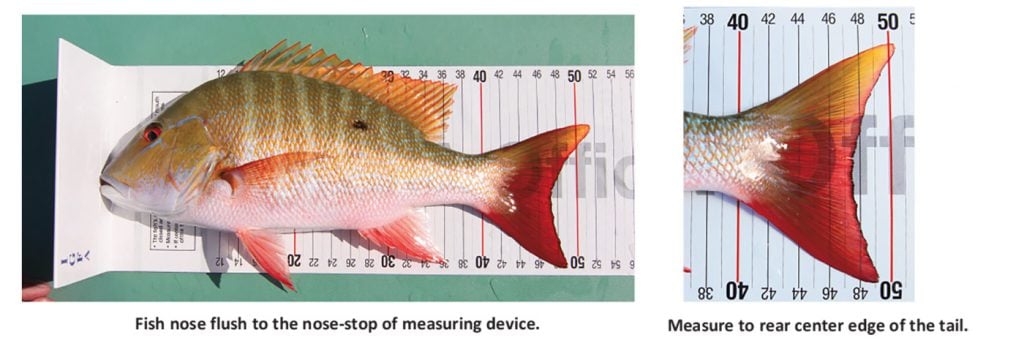
B. Minimum length requirements for vacant records
Fish entered for vacant record categories must measure within the top half of that species maximum recorded length.
C. Minimum length requirements needed to defeat or tie existing records
1. To defeat an existing record, the fish must measure at least two (2) centimeters longer than the existing record.
2. A catch that matches the length of an existing record or exceeds the length by less than two centimeters will be considered a tie. In the case of a tie claim involving more than two catches, length must be compared with the original record (first fish to be caught). Nothing measuring less than the original record will be considered. In the event of an angler tying an existing record they currently hold; the catch must measure at least one centimeter greater than their current record to qualify for a tie.
D. Photographic requirements
Photographs included with applications must contain the following:
1. The full length of the fish on the measuring device clearly showing the position of the mouth and tail. The fish may be held in position, but must be done in a manner that does not obscure the view of the fish on the tape.
2. A close up showing the position of the fish’s nose and tail on the measuring device.
3. The angler with the fish.
4. The rod and reel used to make the catch.
General Best Handling Practices
To remove your fish from the water to document it for record purposes, anglers should use either hands or a knotless, rubberized landing net to minimize slime and scale loss. Lip gripping devices may be used to help subdue fish. However, large fish should not be hoisted vertically out of the water, as this can cause damage to jaw muscle and bone as well as to internal organs. The best method for removing fish from the water by hand is to safely grip the fish and support its underside. Again, the point is always to hold fish horizontally and not vertically.
Documentation
IGFA World Records require pictures and measurement of the catch. All of this takes time, so you should have the necessary equipment ready before landing the fish. If the documentation process takes longer than a minute, periodically place the fish back in the water or place in a live well to allow it to breathe.
Releasing
Considerable care should be exercised when releasing fish. Fish should be placed in the water and held by the base of the tail. If the fish does not swim away from your grasp on its own, gently move it forward in the water to get water flowing over the gills. For best results, move the fish in the forward direction only instead of back and forth. Moving the fish in a slow circle or gently towing it behind the boat will help water flow over the gills in the correct direction.
IGFA World Record Requirements
Game fish catches can only be considered for world record status if they are caught according to the IGFA International Angling Rules. Following is information on world record categories, requirements and procedures for filing claims. All materials submitted as part of the application process become the property of IGFA.
World Record Categories
General Information
IGFA maintains world records for both freshwater and saltwater game fish in All-Tackle, All-Tackle Length, Line Class, Tippet Class and Junior and Smallfry categories. In order to qualify for a record, a catch must be a minimum of .453 kilograms (1 pound) in weight, and must outweigh the existing record by the required amount or meet the minimum weight requirement for vacant records.
No applications will be accepted for fish caught in hatchery waters, sanctuaries or small bodies of water that are stocked with fish for commercial purposes. The intent of this rule shall prevail and IGFA retains the right to determine its applicability on a case-by-case basis. The catch must not be at variance with any laws or regulations governing recreational catch or harvest of the species or waters in which it is caught.
When an additional species of game fish is made eligible for IGFA All-Tackle Length, Line Class, Tippet Class, Junior or Smallfry world records, the effective date will be announced by the IGFA. Fish caught on or after the effective date will be eligible for records. Announcement of an additional species in the World Record Game Fishes book or in other IGFA communications will be considered proper notification in lieu of any other notice.
If an angler submits more than one application for the same record, caught on the same day, only the heaviest or longest of the fish will be accepted.
All-Tackle
All-Tackle World Records are kept for the heaviest fish of a species caught by an angler in any Line Class up to 60 kilograms (130 pounds). All-Tackle record claims are considered for all species of fish caught according to the IGFA International Angling Rules.
All-Tackle record claims for freshwater species must follow the freshwater species Equipment Regulations. All-Tackle record claims for saltwater species must follow the saltwater species Equipment Regulations.
Applications for All-Tackle species not currently included in the IGFA Line Class and Tippet Class listings must meet the following criteria:
1. The fish must represent a valid species with a recognized scientific name.
2. The fish must be identifiable based on photos and other supporting data presented with the application.
3. The fish must be considered “trophy-sized.” A rule of thumb is that the weight must fall within the top half of the maximum reported weight for the species. If no maximum weight is available, it must fall within the top half of the maximum reported length for the species. Maximum reported weight and length for species may be found at www.fishbase.org or from other reputable sources.
All-Tackle Length (Conventional)
All-Tackle Length World Records are kept for the longest fish of each eligible species caught according to the IGFA International Angling Rules in any Line Class up to 60 kilograms (130 pounds) and released alive.
All-Tackle Length (Fly)
All-Tackle Length World Records (fly) are kept for the longest fish of each eligible species caught according to the IGFA International Flyfishing Rules on any Tippet Class up to and including 10 kilograms (20 pounds) and released alive. Fish that are caught on flyfishing tackle on a Tippet Class exceeding 10 kilograms (20 pounds) will be considered for the All-Tackle Length (conventional) category.
All-Tackle Length (Junior)
All-Tackle Length World Records (Junior) are kept for the longest fish of each eligible species caught according to the IGFA International Angling Rules in any Line Class up to 60 kilograms (130 pounds) and released alive. All-Tackle Length Junior records are kept for all anglers ages 16 and under.
Junior All-Tackle
Junior All-Tackle World Records are kept for the heaviest fish of each eligible species in any Line Class up to 60 kilograms (130 pounds). Junior All-Tackle records are kept for both male and female anglers ages 11-16. All species recognized for Line Class records and Tippet Class records are also recognized for Junior All-Tackle records. All IGFA International Angling Rules apply, with the exception that fish do not have to be weighed on land.
Smallfry All-Tackle
Smallfry All-Tackle World Records are kept for the heaviest fish of each eligible species in any Line Class up to 60 kilograms (130 pounds). Smallfry All-Tackle records are kept for both male and female anglers ages 10 and under. All species recognized for Line Class records and Tippet Class records are also recognized for Smallfry All-Tackle records. All IGFA International Angling Rules apply, with the exception that fish do not have to be weighed on land.
Line Class
Line Class world records are kept for each eligible species according to the breaking strength of the first 5 meters (16.5 feet) of line directly preceding the double line, leader or hook. This section must be comprised of a single, homogeneous piece of line. For all Line Class records, the weight of the fish must be at least ½ of the Line Class used to make the catch.
Tippet Class
Tippet Class world records are kept for the eligible species according to the breaking strength of the class tippet. For all Tippet Class records, the weight of the fish must be at least ½ of the Tippet Class used to make the catch.
Junior Line Class
Junior Line Class world records are kept for each eligible species according to the breaking strength of the first 5 meters (16.5 feet) of line directly preceding the double line, leader or hook. This section must be comprised of a single, homogeneous piece of line. Junior Line Class records are kept for both male and female anglers ages 16 and under. For all Junior Line Class records, the weight of the fish must be at least ½ of the Line Class used to make the catch. All IGFA International Angling Rules apply, with the exception that fish do not have to be weighed on land.
Junior Tippet Class
Junior Tippet Class world records are kept for the eligible species according to the breaking strength of the class tippet. Junior Tippet Class records are kept for both male and female anglers ages 16 and under. For all Junior Tippet Class records, the weight of the fish must be at least ½ of the Tippet Class used to make the catch. All IGFA International Angling Rules apply, with the exception that fish do not have to be weighed on land.
World records are kept in the following Line and Tippet classes:
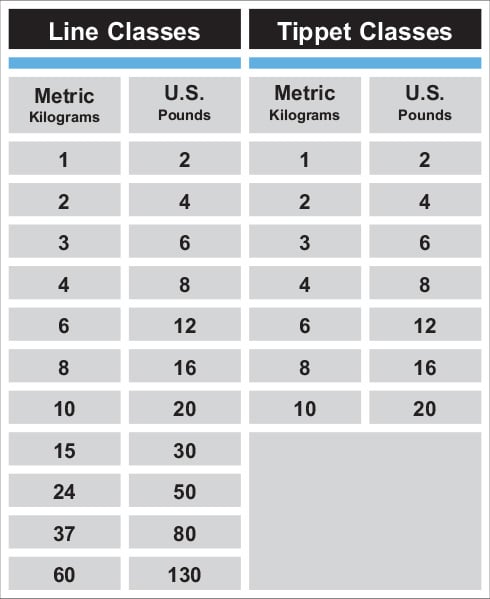
Line Testing
The IGFA tests all line and tippet samples submitted with world record claims using the metric system, which varies slightly from the imperial measurement system. For example, the imperial measurement system equivalent of 4 kilograms is 8.81 pounds. Thus, line designated by the manufacturer as 8-pound class line may test up to 8.81 pounds (4 kilograms) to qualify for a 4-kilogram (8-pound) Line Class world record. The imperial measurement system equivalents in pounds for the metric Line Classes are as follows:
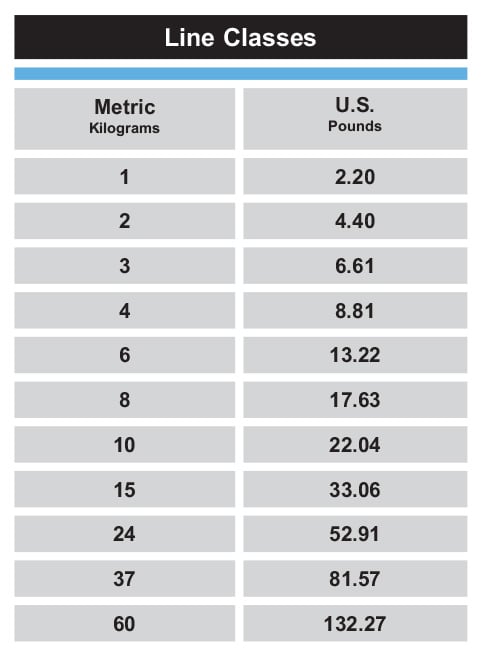
Line and tippet samples submitted with record claims are uniformly tested in accordance with IGFA protocols.
Note: IGFA offers a line and tippet testing service for IGFA members at a fee of $30 USD per sample.
Record Catch Regulations
General Information
1. Protested applications or disputed existing records will be referred to the IGFA Rules Committee for review. Rules Committee decisions may be appealed to the IGFA Board of Trustees. IGFA reserves the right to refuse to consider an application or grant a claim for a record application. All IGFA decisions will be based upon the intent of the regulations.
2. Any and all claims and/or disputes regarding the IGFA International Angling Rules shall be governed by and construed and enforced in accordance with the laws of the State of Florida without regard to such jurisdiction’s conflict of laws principles. In the event that parties are unable to mutually resolve any dispute, controversy or claim arising out of, in connection with, or in relation to the IGFA International Angling Rules, such dispute, controversy or claim shall be resolved by litigation; in that connection, each of the parties to such dispute hereby
(i) irrevocably and unconditionally consents to submit itself to the sole and exclusive personal jurisdiction of any federal or state court located within Broward County, Florida (the “Applicable Courts”),
(ii) waives any objection to the laying of sole and exclusive venue of any such litigation in any of the Applicable Courts,
(iii) agrees not to plead or claim in any such court that such litigation brought therein has been brought in an inconvenient forum and agrees not to otherwise attempt to deny or defeat such personal jurisdiction or venue by motion or other request for leave from any such court, and
(iv) agrees that it will not bring any action, suit, or proceeding in connection with any dispute, claim or controversy arising out of or relating to the Angling Rules in any court or other tribunal other than any of the Applicable Courts. Nothing in this Section shall prevent enforcement in another forum of any judgment obtained in the Applicable Courts.
In the event that it shall become necessary for any party to take action of any type whatsoever to enforce the terms of the IGFA International Angling Rules, the prevailing Party shall be entitled to recover all its costs, including attorneys’ fees, costs, and expenses, including all out-of-pocket expenses that are not taxable as costs, incurred in connection with any such action, including any negotiations, mediations, arbitrations, litigation, and appeal.
3. The IGFA will not recognize or approve any IGFA World Record application where a financial award is offered for obtaining the record.
4. In some instances, an IGFA officer, IGFA representative or a representative from a local IGFA member club may be asked to re-check information supplied on a record application. Such action is not to be regarded as doubt of the formal affidavit, but rather as evidence of the extreme care with which IGFA investigates and maintains its records.
Species Identification
1. Photographs must be submitted by which positive identification of the exact species can be made. Read the photographic requirements at the end of this section. Applications without photographs will not be accepted.
2. If there is the slightest doubt that the fish cannot be properly identified from the photographs and other data submitted, the fish should be examined by an ichthyologist or qualified fishery biologist before a record application is submitted to IGFA. The scientist’s signature, title and qualifications should appear on the IGFA record application form or on a separate document confirming the identification of the species.
3. If a scientist is not available, the fish should be retained in a preserved or frozen condition until a qualified authority can verify the species or until notified by IGFA that the fish no longer needs to be retained.
4. If no decision can be made from the photographs and the angler can provide no further proof of the identification of the species, the record claim will not be considered.
Witnesses to Catch
On all record claims, witnesses to the catch are highly desirable. It is important that the witnesses can attest to the angler’s compliance with the IGFA International Angling Rules and Equipment Regulations.
Minimum Weight Requirements
For all Line Class and Tippet Class categories, the catch must weigh at least ½ as much as the Line Class or Tippet Class. For example, a fish entered for the 6-kilogram (12-pound) Line Class or Tippet Class category must weigh a minimum of 2.72 kilograms (6 pounds).
Weights needed to defeat or tie existing record
1. To replace a record for a fish weighing less than 11.33 kilograms (25 pounds), the replacement must weigh at least 56.69 grams (2 ounces) more than the existing record.
2. To replace a record for a fish weighing 11.33 kilograms (25 pounds) or more, the replacement must weigh at least one half of one percent more than the existing record. For an existing record weighing 45.35 kilograms (100 pounds), the additional weight required to defeat the record would be 226.7 grams (8 ounces).
3. A catch that matches the weight of an existing record or exceeds the weight by less than the amount required to defeat the record will be considered a tie. In the case of a tie claim involving more than two catches, the weight must be compared with the original record (i.e., the first fish caught). No catch weighing less than the original record will be considered. In the event of an angler tying an existing record they currently hold; the catch must weigh at least 28.35 grams (1 ounce) greater than their current record to qualify for a tie.
Time Limits on Claims
With the exception of All-Tackle World Records, claims for record fish caught in U.S. continental waters must be received by IGFA within 60 days of the date of catch. Claims for record fish caught in other waters must be received by IGFA within 90 days of the date of catch.
Weighing Requirements
1. All fish submitted for record consideration must be weighed on scales that have been certified for accuracy by government agencies or other qualified and accredited organizations within the past 12 months. Disinterested witnesses to the weight should be used whenever possible. If at the time of weighing the fish the scale has not been properly certified within the past twelve months, it must be checked and certified for accuracy as quickly as possible, and an official report stating the findings of the inspection prior to any adjustment of the scale must be included with the record application.
2. The weight of the sling, platform or rope (if one is used to secure the fish on the scales) must be determined and deducted from the total weight.
3. No estimated weights will be accepted. With the exception of Junior and Smallfry records, fish must be weighed on land.
4. Only weights indicated by the graduations on the scale will be accepted. Visual fractionalizing of these graduations is not allowed. Any weights that fall between two graduations on the scale must be rounded to the lower of the two.
5. IGFA reserves the right to require any scale to be re-certified for accuracy if there are any indications that the scale might not have weighed correctly.
Note: IGFA offers a scale certification service for IGFA members at a fee of $40 USD.
Preparation of Claims
To apply for a world record, the angler must submit a complete IGFA application form, the mandatory length of line and terminal tackle (described below) used to catch the fish, and acceptable photographs of the fish, the rod and reel used to catch the fish, the scale used to weigh the fish, and the angler with the fish.
Application Form
A current, official IGFA world record application form must be used for record claims. This form may be found on the www.igfa.org website or in the 2019 World Record Game Fishes book. No other version of the application form will be accepted.
When making any record claim, the angler must indicate the specified strength of the line or tippet used to catch the fish. In the cases of Line Class and Tippet Class records, this will place the claim in an IGFA Line or Tippet Class category (see Line Class and Tippet Class categories). All lines and tippets will be examined by IGFA to verify the specified strength of the line. If the line or tippet over tests its class, the application will be considered in the next highest class. If the line or tippet under tests into a lower Line or Tippet Class, the application will not be considered for the lower Line Class or Tippet Class. The heaviest Line Class permitted for both freshwater and saltwater records is 60 kilograms (130 pounds). The heaviest Tippet Class permitted for Tippet Class records is 10 kilograms (20 pounds). If the line or tippet over tests these maximum strengths, the claim will be denied.
Extreme care should be exercised in measuring the fish, as the measurements are often important for weight verification and scientific studies. See the measurement diagram on the record application to be sure the fish is measured correctly.
The angler is responsible for obtaining the necessary signatures and correct addresses of the boat captain (where applicable), weighmaster (where applicable) and witnesses on the application. If an IGFA officer or representative, or an officer or member of an IGFA club is available, he or she should be asked to witness the claim.
Any deliberate falsification of an application will disqualify the applicant for any future IGFA World Record and any existing records will be nullified.
Line or Tippet Sample
All applications caught on fly fishing tackle must be accompanied by the fly, the entire tippet and the entire leader connected in one piece.
All applications caught on conventional tackle must be accompanied by the entire leader (including the hook(s)), the double line and at least 5 meters (16.5 feet) closest to the double line, leader or hook. All line samples and the leader (if one is used) are to be submitted in one piece. Broken or incomplete line samples must be accompanied by a full explanation. The IGFA reserves the right to reject applications with broken line samples that prevent it from testing the breaking strength and/or verifying the length of the double line and leader. If a lure is used with the leader, the leader should be cut at the eye attachment to the lure. Each line sample must be submitted in a manner that it can be easily unwound without damage to the line. A recommended method is to take a rectangular piece of stiff cardboard and cut notches in two opposite ends. Secure one end of the line to the cardboard and wind the line around the cardboard through the notched areas. Secure the other end, and write your name and the specified strength of the line on the cardboard. Any line sample submitted that is tangled or cannot be easily unwound will not be accepted.
Photographic Requirements
Photographs showing the full length of the fish, the rod and reel used to make the catch, and the scale used to weigh the fish must accompany each record application. A photograph of the angler with the fish is also required.
For species identification, the clearest possible photos should be submitted. This is especially important in the cases of hybrids and fishes that may be confused with similar species. Shark applications should include a photograph of the shark’s teeth and of the head and back taken from above in addition to the photographs taken from the side. Whether the shark has or does not have a ridge between the dorsal fins should be clearly evident in this photograph for identification purposes.
For best results, photograph the fish broadside to the camera so that no part of the fish is obscured. The fins should be fully extended and not obscured with the hands in cases where the number of spines and rays need to be counted. When photographing a fish lying on its side, the surface beneath the fish should be smooth and a ruler or marked tape placed beside the fish if possible. Photographs from various angles are most helpful. An additional photograph of the fish on the scale with actual weight visible is also helpful.
It is important that we have clear, publishable photographs of the fish and the angler, including action shots, if available. Original, high resolution digital files are preferred and will assist the IGFA in publicizing the world record catch. The IGFA encourages anglers to release record fish whenever possible and we prefer to see photos of fish carefully being held horizontally, and not vertically, to prevent harming the fish.
Conversion Formulas for
Weights & Measures
Persons submitting world record claims are required to provide the weights and measurements of the fish in the units in which they were taken. The following formulas are provided for your information.

IGFA Release Guidelines
For the purposes of qualifying catches for IGFA Grand Slams and determining releases in recreational fishing tournaments please visit here.




